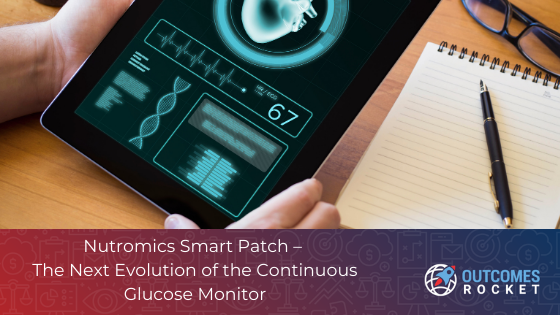
Diabetes is one of the leading causes of death and disability in the United States. Besides directly costing the healthcare system $327 billion in medical costs and lost productivity, it is one of the more common causes of other chronic illnesses like Chronic Kidney Disease (CKD)
1 in 7 people, i.e. 37 million U.S. adults, suffer from CKD, and as many as 9 in 10 of those are undiagnosed. Furthermore, chronic illnesses like CKD increase the chances of heart disease and strokes, which cost the healthcare system $124 billion a year.
Chronic diseases can thus open the floodgates to a host of complications and more severe illnesses. The problem of lifestyle-related chronic disease is so significant that the CDC estimates that 90% of healthcare spending goes toward chronic disease management.
With lives at stake and billions of dollars lost every year, it is crucial to find a solution to reduce, if not prevent, the incidence of chronic diseases.
One company committed to finding a solution through a proactive approach to healthcare is Nutromics.
Nutromics is an Australian medical technology company revolutionizing healthcare through Continuous Molecular Monitoring. The company is developing a patch-based sensor that can continuously monitor hormones, proteins, metabolites, and drugs in the body delivering real-time data and insights for improved health outcomes and better quality of life.
I had the chance to interview Peter Vranes, co-founder of Nutromics, in the podcast, and he explained how the patch works.
“Our device works by combining two technologies. One’s a sensor, and the other’s a set of small needles. The needles (as long as the edge of a dime- less than 1mm) give us access to a fluid under your skin called interstitial fluid. We coat the tips of those needles with our sensor. It’s called an aptamer sensor, and it’s specifically designed to determine how much of a biomarker you have in your body. It’s by combining these two innovative technologies that we can form our Continuous Molecular Monitoring platform,” Peter said.
The sensor captures the biomarker data and transmits it to a software application, which can be accessed on any device. The software solution is simple for patients to use and designed so that the data is accessible to clinicians from the software they use every day.
According to Peter, the aptamer sensor technology is highly extendable. It is because of this that “it can be applied to so many key problems faced in healthcare today – including both the prevention of chronic diseases and the management of acute diseases.” This extendibility is what differentiates the Nutromics platform from current commercially available continuous monitoring devices, which can only monitor a single molecule – glucose.
The best part? You don’t have to be a health professional to put it on. You can apply it yourself.
Preventing chronic disease
In the U.S., six in 10 adults have chronic diseases.
The numbers are alarming, but tools like the aptamer sensor can help stop chronic diseases’ progression, ensuring a higher quality of life, free from fear and uncertainty.
Through the skin patch, continuous monitoring of biomarkers related to kidney health, nutrition, drug dosage etc., is easy. People can take a proactive approach to monitor their health conditions, empowering them to take action before their health condition worsens.
Imagine for a second that you have CKD and are wearing Nutromics’ aptamer sensor. Your creatinine levels start to rise, but you do not feel this rise since it is asymptomatic. Your sensor, however, captures this rise above the baseline level and alerts you to go to the hospital immediately. A situation that could have resulted in severe complications, such as kidney failure, has been diffused, prolonging your life.
With early interventions, whether that means changing one’s diet, medication, or nutrition, further deterioration in conditions like kidney disease, strokes, diabetes, etc., can be prevented.
Managing acute disease
Patients with acute diseases require regular monitoring by attending clinicians to get accurate information. In most cases, chronically ill patients have to stay in the hospital longer for more observation and blood tests. This is necessary to improve patient outcomes and reduce costs.
But when patients leave the hospital, what happens to the monitoring? Currently, the safety net post-hospital discharge is very poor. Often patients don’t even know they need to come in till they show extreme symptoms, which means the system is reactive rather than proactive.
Nutromics’ aptamer sensor allows patients to go home and still experience the continuous monitoring needed to detect any changes in the disease. It acts as an early warning system that can flag issues in time.
Peter shared that the company’s first focus area is therapeutic drug monitoring. “Right now, monitoring drug levels in patients to ensure they don’t receive a toxic dose is challenging to do. This means that many patients are essentially overdosed on toxic drugs. The impact of this can be severe – for example, high levels of vancomycin are known to cause acute kidney injuries in over 10% of patients given vancomycin in a hospital.”
He explained that if a patient gets dosed with a drug that requires therapeutic drug monitoring, multiple blood tests are necessary to obtain the data needed for decision-making. However, long lab processing times mean that clinicians get approximately 1 data point every 12 hours. This information is then extrapolated to make decisions about drug dosage. Narrow therapeutic ranges mean dire consequences if the drug concentration is out of range.
For example: With the antibiotic vancomycin, if the drug concentration goes over the recommended range, patients may develop acute kidney injury, which costs the healthcare system an extra $10,000 per incident.
Nutromics’ aptamer sensor gives clinicians accurate, real-time data, delivering the promise of precision medicine.
Nutromics innovative Smart Patch is being designed and manufactured in Australia. The whole team is working towards the Smart Patch’s market release by early 2023. With the promise of delivering continuous IRL tracking, this technology has the power to make Nutromics’ vision of zero preventable deaths due to a lack of molecular-level data a reality.
For more information on the Smart Patch, you can listen to my podcast interview with Peter here: https://outcomesrocket.health/nutromics/2021/02/.
According to the 2020 Centers for Disease Control and Prevention report, roughly 34.2 million Americans have diabetes,...
Read MoreAs a farmer, Rod was used to long days. He worked 18 hours a day, 7 days...
Read MoreWith investors receiving hundreds of pitch decks every year, how do you create a compelling presentation that...
Read More
Brittany Busse Co-Founder, President, and Chief Medical Officer at
ViTelHealth


Stephen Thorne Founder and CEO at
Pacific Dental Services

Keith Carlson Nurse Career Coach